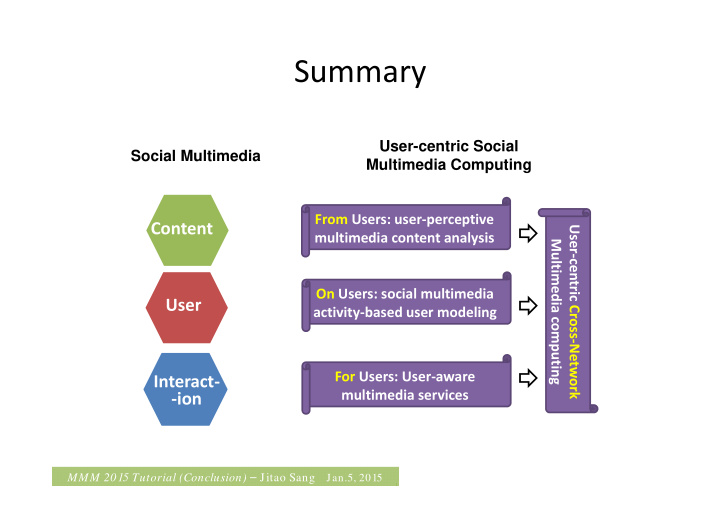



Summary User-centric Social Social Multimedia Multimedia Computing From Users: user-perceptive Content User-centric Cross-Network multimedia content analysis Multimedia computing On Users: social multimedia User activity-based user modeling For Users: User-aware Interact- multimedia services -ion MMM 2015 Tutorial (Conclusion) – Jitao Sang Jan.5, 2015
Practical Challenges
Lack of Benchmark Dataset Large-scale benchmark dataset on respective multimedia, user, and social network, but none including all of them. Due to the problem variety, most researches conduct experiments on the self-collected dataset. The lack of benchmark dataset discourages the follow-ups of other researchers and the progress of new problems. MMM 2015 Tutorial (Conclusion) – Jitao Sang Jan.5, 2015
Evaluation Dilemma User ground-truth intent and demands are difficult to obtain in open network environment, especially for the personalized information services. Existing data-driven evaluation strategies are either unable to reflect real intent/preferences or limited in scale (e.g., favorite record as indication of preference). MMM 2015 Tutorial (Conclusion) – Jitao Sang Jan.5, 2015
Privacy Privacy breach: learn the private information of an individual from the publicly available user data. ( “We know where you live.” LBSN 2012. ) MMM 2015 Tutorial (Conclusion) – Jitao Sang Jan.5, 2015
Privacy Privacy breach: learn the private information of an individual from the publicly available user data. Data anonymization is not adequate to preserve privacy: social media data exhibit rich dependencies. MMM 2015 Tutorial (Conclusion) – Jitao Sang Jan.5, 2015
Promising Topics
From Users : Knowledge Base Construction Social multimedia involves with rich multimedia information and complicated user and community social information. To facilitate user services as well as pursue multimedia understanding, it is of particular significance to construct social multimedia knowledge base that: (1) connects between heterogeneous data, and (2) integrates user awareness/perception. MMM 2015 Tutorial (Conclusion) – Jitao Sang Jan.5, 2015
On Users : Heterogeneous Data Integration User-MM + User-User : Social media users interact with each other, (e.g., adding friends, joining in interest groups), and with multimedia content, (e.g., sharing, annotation, commenting). Cross-network: Users data are distributed on various social media networks, e.g., acquiring news via Twitter, sharing videos via YouTube, and chatting with friends via Facebook. MMM 2015 Tutorial (Conclusion) – Jitao Sang Jan.5, 2015
For Users : Unified Theoretical Framework Social multimedia computing is still in the primary stage. 20 17 15 13 13 12 11 9 10 5 0 ~2009 2010 2011 2012 2013 2014 It is a promising research line to refer to classical theoretical work from information retrieval, multimedia analysis and social network analysis, to develop the theoretical framework for social multimedia computing. MMM 2015 Tutorial (Conclusion) – Jitao Sang Jan.5, 2015
The Prospects
User connects cyber to the physical worlds. MMM 2015 Tutorial (Conclusion) – Jitao Sang Jan.5, 2015
User-centric Cyber-Physical Association and Collaboration Overlapping user-based cyber-physical collaboration. Cyber activities Aggregated User Modeling Common user mining Social Network Analysis User Information Cyber-Physical Integration Collaboration Physical attributes MMM 2015 Tutorial (Conclusion) – Jitao Sang Jan.5, 2015
Cyber-Social-Physical Spaces Cyber space Socio Socio Event space space Physical space Cyber-social-physical spaces MMM 2015 Tutorial (Conclusion) – Jitao Sang Jan.5, 2015
Cyber-Social-Physical Computing Social event detection and tracking in cyber-social-physical spaces. Cyber space Online activity Jan, 2011 May, 2011 Sep, 2011 Jan, 2012 Time Physical behavior Physical space MMM 2015 Tutorial (Conclusion) – Jitao Sang Jan.5, 2015
User will be the fundamental computing terminal. 视频语义特征提取 MMM 2015 Tutorial (Conclusion) – Jitao Sang Jan.5, 2015
Computing is tending decentralized MMM 2015 Tutorial (Conclusion) – Jitao Sang Jan.5, 2015
Individual computational capability has significantly increased MMM 2015 Tutorial (Conclusion) – Jitao Sang Jan.5, 2015
Social Multimedia + Pervasive Computing content understanding Social Multimedia Computing user modeling Internet of Things Pervasive application scenario Computing resource allocation MMM 2015 Tutorial (Conclusion) – Jitao Sang Jan.5, 2015
Take Home Message • User is the basic data collection unit. • User is the ultimate information service target. • User connects cyber to the physical worlds. • User will be the fundamental computing terminal. MMM 2015 Tutorial (Conclusion) – Jitao Sang Jan.5, 2015
Collaborators Quan Fang, 3 nd -year PhD student Research Topic: Geographical Multimedia Mining and Location-based personalized services Zhengyu Deng, 4 th -year PhD student Research Topic: Cross-network User Modeling and Changsheng Xu Personalized Recommendation Professor, Multimedia Computing Group, NLPR, CASIA Ming Yan, 2 nd -year PhD student Research Topic: Cross-network Knowledge Association Mining
Thank you. Contact • jtsang@nlpr.ia.ac.cn • http://www.nlpr.ia.ac.cn/mmc/homepa ge/jtsang.html • Multimedia Computing Group, National Lab of Pattern Recognition, CASIA
Recommend
More recommend